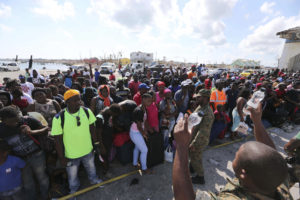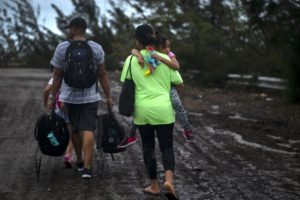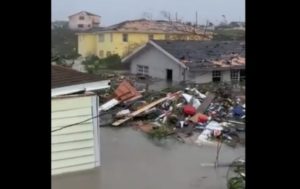Hurricane Dorian Batters the Carolinas as It Pushes Northward
Its 110-mph winds and storm-surge flooding causes havoc after sweeping past Florida and Georgia and leaving at least 20 dead in the Bahamas.CHARLESTON, S.C.—Hurricane Dorian raked the coastal Carolinas with howling, window-rattling winds and sideways rain Thursday, spinning off tornadoes and knocking out power to more than 200,000 homes and businesses as it pushed northward toward the dangerously exposed Outer Banks.
Leaving at least 20 people dead in its wake in the devastated Bahamas, Dorian made its way up the Eastern Seaboard, sweeping past Florida on Wednesday at a relatively safe distance. From there, the storm apparently grazed Georgia overnight, then hugged the South Carolina coast with more serious effects.
It strengthened briefly to a Category 3 hurricane, then dropped back to a Category 2, with winds of 110 mph, still a threat to hundreds of miles of coastline.
“Get to safety and stay there,” North Carolina Gov. Roy Cooper said. “This won’t be a brush-by. Whether it comes ashore or not, the eye of the storm will be close enough to cause extensive damage in North Carolina.”
An estimated 3 million people in Florida, Georgia and the Carolinas were warned to evacuate as the storm closed in. Navy ships were ordered to ride it out at sea, and military aircraft were moved inland.
At least two deaths were reported on the U.S. mainland, in Florida and North Carolina, both involving men who fell while getting ready for the storm.
The National Hurricane Center’s projected track showed Dorian passing near or over North Carolina’s Outer Banks on Friday, lashing the thin line of islands that stick out from the U.S. coast like a boxer’s chin. Dorian was then expected to peel away from the shoreline.
“I think we’re in for a great big mess,” said Leslie Lanier, who decided to stay behind and boarded up her home and bookstore on Ocracoke Island on the Outer Banks, making sure to move the volumes 5 to 6 feet off the ground.
“We are thinking maybe we should have moved the books higher because of storm surge,” Lanier said. “But we’re kind of to the point where we can’t do much more.”
In an assault that began over Labor Day weekend, Dorian pounded the Bahamas with Category 5 winds up to 185 mph (295 kph), obliterating entire neighborhoods and triggering a humanitarian crisis.
About 830,000 people were under mandatory evacuation orders on the South Carolina coast alone.
The National Hurricane Center forecast as much as 15 inches of rain for the coastal Carolinas, with flash-flooding likely.
In Charleston, South Carolina, a historic port city of handsome antebellum homes on a peninsula that is prone to flooding even from ordinary storms, the wind sent sheets of rain sideways, thunder boomed in the night sky, and power flickered on and off as the storm closed in. More than two dozen blocks were closed by flooding in the city, where stores and restaurants downtown were boarded up with wood and corrugated metal.
The hurricane’s approach coincided with a rising tide in the afternoon that forecasters said could worsen flooding in the city.
Dorian also apparently spun off at least one tornado in North Myrtle Beach, South Carolina, damaging several homes, city spokesman Patrick Dowling said. The beach town of Emerald Isle, North Carolina, said a tornado touched there, too, and it posted pictures of smashed homes and RVs. No injuries were reported.
By late morning, in coastal Wilmington, North Carolina, just above the South Carolina line, heavy rain fell sideways, trees bent in the wind and traffic lights swayed.
At 11 a.m. EDT Thursday, the hurricane was centered about 50 miles (80 kilometers) southeast of Charleston, moving north at 8 mph (13 kph) with winds of 110 mph (175 kph) extending about 60 miles (95 kilometers) outward.
Hundreds of shelter animals from coastal South Carolina arrived in Delaware ahead of the storm. The News Journal of Wilmington, Delaware, said 200 were airlifted early Tuesday from shelters in danger of flooding. About 150 more were expected to arrive via land.
In Georgia, evacuation orders covering hundreds of thousands of people along the coast were lifted Thursday morning after the shoreline was largely spared by Dorian overnight.
Mayor Jason Buelterman of Tybee Island, Georgia, said the beach community of 3,000 people came through it without flooding, and the lone highway linking the island to Savannah on the mainland remained open throughout the night.
“If the worst that comes out of this is people blame others for calling evacuations, then that’s wonderful,” he said.
Tybee Islander Bruce Pevey went outside to take photos of unscathed homes to text to neighbors who evacuated. The storm, he said, turned out to be “a bunch of nothing.”
___
Associated Press reporters Russ Bynum in Tybee Island, Georgia; Gary Robertson in Raleigh, North Carolina; Jeffrey Collins in Carolina Beach, North Carolina; Jay Reeves in Birmingham, Alabama; and Seth Borenstein in Washington contributed to this report.
Your support matters…Independent journalism is under threat and overshadowed by heavily funded mainstream media.
You can help level the playing field. Become a member.
Your tax-deductible contribution keeps us digging beneath the headlines to give you thought-provoking, investigative reporting and analysis that unearths what's really happening- without compromise.
Give today to support our courageous, independent journalists.







You need to be a supporter to comment.
There are currently no responses to this article.
Be the first to respond.